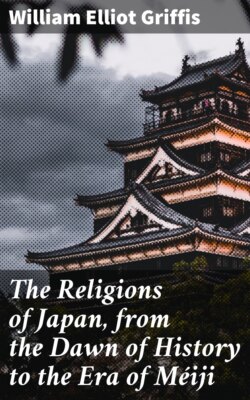Читать книгу The Religions of Japan, from the Dawn of History to the Era of Méiji - William Elliot Griffis - Страница 26
На сайте Литреса книга снята с продажи.
Mikadoism the Heart of Shint[=o].
ОглавлениеTable of Contents
As success came to their arms and their chief's power was made more sure, they developed further the dogma of the Mikado's divinity and made worship centre in him as the earthly representative of the Sun and Heaven. His fellow-conquerors and ministers, as fast as they were put in lordship over conquered provinces, or indigenous chieftains who submitted obediently to his sway or yielded graciously to his prowess, were named as founders of temples and in later generations worshipped and became gods.10 One of the motives for, and one of the guiding principles in the selections of the floating myths, was that the ancestry of the chieftains loyal to the Mikado might be shown to be from the heavenly gods. Both the narratives of the "Kojiki" and the liturgies show this clearly.
The nature-worship, which was probably practised throughout the whole archipelago, became part of the system as government and society were made uniform on the Yamato model. It seems at least possible, if Buddhism had not come in so soon, that the ordinary features of a religion, dogmatic and ethical codes, would have been developed. In a word, the Kami no Michi, or religion of the islanders in prehistoric times before the rise of Mikadoism, must be carefully distinguished from the politico-ecclesiasticism which the system called Shint[=o] reveals and demands. The early religion, first in the hands of politicians and later under the pens and voices of writers and teachers at the Imperial Court, became something very different from its original form. As surely as K[=o]b[=o] later captured Shint[=o], making material for Buddhism out of it and overlaying it in Riy[=o]bu, so the Yamato men made political capital out of their own religion and that of the subject tribes. The divine sovereign of Japan and his political church did exactly what the state churches of Europe, both pagan and Christian, have done before and since the Christian era.
Further, in studying the "Kojiki," we must remember that the sacred writings sprang out of the religion, and that the system was not an evolution from the book. Customs, ritual, faith and prayer existed long before they were written about or recorded in ink. Moreover, the philosophy came later than the practice, the deeds before the myths, and the joy and terror of the visible universe before the cosmogony or theogony, while the book-preface was probably written last of all.
The sun was first, and then came the wonder, admiration and worship of men. The personification and pedigree of the sun were late figments. To connect their ancestors with the sun-goddess and the heavenly gods, was a still later enterprise of the "Mikado reverencers" of this earlier time. Both the god-way in its early forms and Shint[=o] in its later development, were to them political as well as ecclesiastical institutes of dogma. Both the religion which they themselves brought and cultivated and the aboriginal religion which the Yamato men found, were used as engines in the making of Mikadoism, which is the heart of Shint[=o].
Not until two centuries after the coming of Buddhism and of Asiatic civilization did it occur to the Japanese to reduce to writing the floating legends and various cycles of tradition which had grown up luxuriantly in different parts of "the empire," or to express in the Chinese character the prayers and thanksgivings which had been handed down orally through many generations. These norito had already assumed elegant literary form, rich in poetic merit, long before Chinese writing was known. They, far more than the less certain philosophy of the "Kojiki," are of undoubted native origin. It is nearly certain that the prehistoric Japanese did not borrow the literary forms of the god-way from China, as any one familiar with the short, evenly balanced and antithetical sentences of Chinese style can see at once. The norito are expressions, in the rhythmical and rhetorical form of worship, of the articles of faith set forth in the historic summary which we have given. We propose to illustrate the dogmas by quoting from the rituals in Mr. Satow's masterly translation. The following was addressed to the sun-goddess (Amatéras[)u] no Mikami, or the From-Heaven-Shining-Great-Deity) by the priest-envoy of the priestly Nakatomi family sent annually to the temples at Isé, the Mecca of Shint[=o]. The sevran referred to in the ritual is the Mikado. This word and all the others printed in capitals are so rendered in order to express in English the force of "an untranslatable honorific syllable, supposed to be originally identical with a root meaning 'true,' but no longer possessing that signification." Instead of the word "earth," that of "country" (Japan) is used as the correlative of Heaven.
